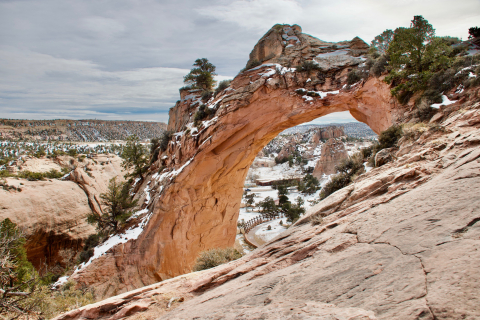You are here
Nicole Slowman had recently obtained her Master of Public Health degree. Larissa Cruz was just getting hers.
Nicholas Rolig, MPH, CPH, was back in the United States from Zambia after a mass evacuation of Peace Corps Response Volunteers.
Tori Sergent, MPH, was evacuated from her job in South Sudan, where she’d been working on a Guinea Worm Eradication program.
And Uly Labilles, DMD, PhD was working as a private consultant focused primarily on laboratory staff development related to Mohs Micrographic surgery.
All were eager to contribute to the COVID-19 public health emergency response. And all ended up working for the CDC Foundation in support of the Navajo Nation—an early hot-spot in the pandemic, turned model for successful mitigation.
“In the midst of the surges on the Navajo Nation, the Foundation team played a valuable role in mitigating COVID-19. They are a piece to our ongoing response to the pandemic. Ahéhee,’” said Dr. Jill Jim, executive director, Navajo Department of Health/Health Command Operations Center, invoking the Navajo expression of gratitude.
Tori Sergent, Nicholas Rolig and Nicole Slowman en route to their COVID-19 vaccination appointments.
First lady Jill Biden visited the Navajo capital Window Rock in April to praise the COVID-19 vaccination effort. (Official White House Photo by Cameron Smith)
Navajo Nation President Jonathan Nez and CDC Foundation President Judy Monroe made guest appearances at a recent community of practice video call led by CDC Foundation epidemiologist Uly Labilles.
First Lady Jill Biden visited the tribal nation’s capital in late April to praise Navajo Nation’s prompt vaccination efforts, which at the time included vaccinating more than half of those living on tribal lands. By early May, more than 100,000 tribal members were fully vaccinated, despite the remote region’s ubiquitous challenges with resources and access. Navajo Nation is the largest Indian reservation in the United States, spanning 25,000 square miles across portions of Arizona, Utah and New Mexico.
Navajo Nation’s public health and healthcare teams are not taking their eye off the ball. They acknowledge there is still much work to be done. That work includes continued contact tracing, addressing mental health, social determinants of health, and basic infrastructure like water and electricity, and post-COVID care.
“I’m always very cautious,” said CDC Foundation epidemiologist Uly Labilles. “While vaccination is rolled out already, testing and contact tracing still play a vital role in the Navajo Nation until we reach the herd immunity threshold.” Labilles spearheads the Navajo Nation Unified COVID-19 Community of Practice forum and co-leads the tribe’s testing strategy, data and analytics, and vaccination data teams. He’s also working on genomic characterization and viral sequencing to track COVID strains and variants, and he’s participating in an Indian Health Service (IHS)-led initiative looking at long or post-COVID syndrome.
He’s a busy guy, along with the rest of the CDC Foundation team helping the Navajo Department of Health shore up its COVID-19 response efforts.
Nicole Slowman, MPH
Uly Labilles, DMD, PhD
Larissa Cruz, MPH, and her work-from-home cubicle buddy.
Epidemiologists Tori Sergent and Larissa Cruz are considered the ‘go-to’ people for specific COVID-19 data. They are heavily involved in data analysis and tracking for Navajo Nation. Sergent has been instrumental in providing regular reports including cluster investigations and in helping to automate analytics and measures. Cruz focuses primarily on gating measures—the data-driven criteria for safely reopening—and on aggregating vaccine data from multiple streams, including IHS clinics and tribally-run clinics.
“The Navajo Nation set up this really amazing system to track contact tracing and cases and do the gating indicators, and they basically built it from scratch,” Sergent said. “It's going to be really valuable for them moving forward. Now that they have the structure in place, they can adapt it for whatever infectious diseases may come next.”
Contact Tracing and Case Investigation Team Lead Nicholas Rolig agrees. “[DoH] office capacity has gone through the roof with COVID and it has been fantastic to see and be a part of.” Rolig is the Foundation team’s “Johnny on the spot.” He works on a variety of projects and serves as a point of contact for the current CDC deployment on Navajo Nation. He also helps facilitate contact tracing data meetings, leads the cluster investigation team, provides technical support, and ensures compliance with the submission of contact tracing and case reports.
Senior Public Health Advisor Nicole Slowman, an enrolled member of the Navajo Nation, works directly under Dr. Jim, the executive director of the Navajo Department of Health. Slowman has been able to leverage her deep understanding of the Navajo landscape, culture and political structure to coordinate health communications across the reservation. She helps identify what needs to get done, especially as the focus shifts toward guidelines for reopening schools, businesses, and parks—to Navajo residents and tourists. With family still living “on the rez,” Slowman says her professional mission is also a deeply personal one.
“This influx of support has really helped with some of the Nation’s long-term sustainability,” Slowman said, noting the pandemic raised awareness of infrastructure challenges the tribe has been dealing with for decades. She says current efforts to increase access to water, electricity, broadband and the like go hand-in-hand with a fortified public health workforce and response. “Having that support to sustain the structure long term, that would be amazing to see.”

This article is supported by the Centers for Disease Control and Prevention (CDC) of the U.S. Department of Health and Human Services (HHS) as part of a financial assistance award totaling $68,939,536 with 100 percent funded by CDC/HHS. The contents are those of the author(s) and do not necessarily represent the official views of, nor an endorsement by, CDC/HHS or the U.S. Government.
